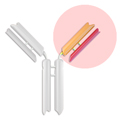
FabuLight™ antibodies are Fab fragment secondary antibodies specific to the Fc region of IgG or IgM primary antibodies
Fabulight™ Antibodies from Jackson ImmunorResearch are available conjugated with 9 different fluorophores and biotin, and enable labeling of primary antibodies prior to incubation with cells or tissue. This provides a time-saving alternative to sequential incubation flow cytometry and immunohistochemistry procedures, without compromising the active site of the primary antibody.
FabuLights™ can be used to label Fc domains of fusion proteins, or cell surface immunoglobulins, without cross-linking or activating cells.
FabuLights™ are not cross-adsorbed against other species, so blocking steps may be required to avoid labeling endogenous immunoglobulins. For advice on developing protocols, refer to the example protocol overleaf.
Save time and preserve cells by reducing incubation and washing steps
Incubation with FabuLight-labeled primary antibodies requires fewer washes than sequential incubation with primary antibodies and labeled secondary antibodies, thereby reducing damage to cells in flow cytometry protocols. Incubation steps in protocols requiring multiple primary antibodies from the same host animal are also reduced.
No precipitation or aggregation
FabuLight binds to the Fc portion of the primary antibody (either anti-IgG, Fcγ specific or anti-IgM, μ chain specific), leaving the antigen-binding region active.
No interference with the primary antibody active site
The resulting complex of primary antibody with FabuLight does not precipitate or aggregate, because the dye-conjugated Fab anti-Fc secondary antibody fragments are monovalent. FabuLight-primary antibody complexes offer good tissue penetration and low non-specific binding.
Technical tips for using FabuLight™
Optimal protocols for each application must be established empirically
- FabuLight antibodies have not been adsorbed to remove cross-reactivities to other species, so it may be necessary to block endogenous IgG prior to incubation with an unlabeled FabuLight prior to application of a FabuLight-labeled complex.
- FabuLight-labeled complexes do not provide as bright a signal as sequential incubation with a primary antibody followed by incubation with a labeled secondary antibody.
- To avoid displacement of the FabuLight-primary antibody by a subsequent labeled secondary antibody, a light cross-linking with glutaraldehyde may be necessary, provided that it does not affect antigenicity of subsequent target proteins.
- For all multiple labeling applications, we recommend incubating FabuLights sequentially to minimize cross-reactivity.
- Label the less abundant target antigen first for best results.
- For IgG class primary antibodies, complexing at a 3:1 molar ratio of FabuLight-primary antibody (equal weight ratios) provides a good degree of labeling of the primary antibody without excessive amounts of unbound FabuLight.
- For IgM primary antibodies, use a 15:1 molar ratio of FabuLight-primary antibody (equal weight ratios).
- Titrate FabuLight-labeled complexes vs. their target antigens to minimize the amount of free Fab anti-Fc, thereby minimizing potential mislabeling in a multiple labeling application.
